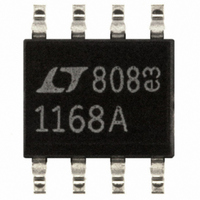LT1168ACS8#PBF Linear Technology, LT1168ACS8#PBF Datasheet - Page 13

LT1168ACS8#PBF
Manufacturer Part Number
LT1168ACS8#PBF
Description
IC AMP INSTR PREC PROG 8-SOIC
Manufacturer
Linear Technology
Specifications of LT1168ACS8#PBF
Amplifier Type
Instrumentation
Number Of Circuits
1
Slew Rate
0.5 V/µs
Gain Bandwidth Product
400kHz
Current - Input Bias
40pA
Voltage - Input Offset
15µV
Current - Supply
350µA
Current - Output / Channel
32mA
Voltage - Supply, Single/dual (±)
4.6 V ~ 36 V, ±2.3 V ~ 18 V
Operating Temperature
0°C ~ 70°C
Mounting Type
Surface Mount
Package / Case
8-SOIC (3.9mm Width)
Lead Free Status / RoHS Status
Lead free / RoHS Compliant
Output Type
-
-3db Bandwidth
-
Available stocks
Company
Part Number
Manufacturer
Quantity
Price
THEORY OF OPERATIO
Single Supply Operation
For best results under single supply operation, the REF pin
should be raised above the negative supply (Pin 4) and one
of the inputs should be at least 2.5V above ground. The
barometer application later in this data sheet is an example
that satisfies these conditions. The resistance R
the bridge transducer to ground sets the operating current
for the bridge, and with R6, also has the effect of raising the
input common mode voltage. The output of the LT1168 is
always inside the specified range since the barometric
pressure rarely goes low enough to cause the output to clip
(30.00 inches of Hg corresponds to 3.000V). For applica-
tions that require the output to swing at or below the REF
–V
+V
–2
–3
–4
–5
–6
–7
–8
–1
Figure 3. Negative Input Voltage Range
vs Output Voltage for Various Gains
9
7
6
5
4
2
8
3
1
S
S
–14
0
T
INPUT COMMON
MODE RANGE IS
BELOW THE CURVE
Figure 2. Positive Input Range vs
Output Voltage for Different Gains
OPERATION
A
= 25°C
AREA OF
–12
2
OPERATION
G = 2
AREA OF
AREA OF OPERATION
G = 100
G = 10
AREA OF
OPERATION
–10
4
AREA OF OPERATION
G = 1
–8
V
V
6
OUT
OUT
G = 1
(V)
(V)
– 6
8
T
INPUT COMMON
MODE RANGE IS
ABOVE THE CURVE
A
= 25°C
G = 100
AREA OF
OPERATION
10
–4
G = 2
AREA OF
OPERATION
G = 10
AREA OF
OPERATION
12
–2
U
1168 F03
1168 F02
14
0
SET
from
potential, the voltage on the REF pin can be further level
shifted. The application in the front of this data sheet,
Single Supply Pressure Monitor, is an example. An op amp
is used to buffer the voltage on the REF pin since a parasitic
series resistance will degrade the CMRR.
Output Offset Trimming
The LT1168 is laser trimmed for low offset voltage so that
no external offset trimming is required for most applica-
tions. In the event that the offset needs to be adjusted, the
circuit in Figure 4 is an example of an optional offset adjust
circuit. The op amp buffer provides a low impedance to the
REF pin where resistance must be kept to minimum for
best CMRR and lowest gain error.
Input Bias Current Return Path
The low input bias current of the LT1168 (250pA) and the
high input impedance (200GΩ) allow the use of high
impedance sources without introducing additional offset
voltage errors, even when the full common mode range is
required. However, a path must be provided for the input
bias currents of both inputs when a purely differential
signal is being amplified. Without this path the inputs will
float to either rail and exceed the input common mode
range of the LT1168, resulting in a saturated input stage.
Figure 5 shows three examples of an input bias current
–IN
+IN
Figure 4. Optional Trimming of Output Offset Voltage
R
G
2
1
8
3
–
+
LT1168
ADJUSTMENT RANGE
REF
±10mV
5
1/2 LT1112
6
OUTPUT
–
+
10k
LT1168
+V
–V
S
S
10mV
100Ω
100Ω
–10mV
13
1168 F04
1168fa













